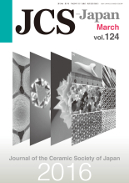124 巻, 3 号
(March)
選択された号の論文の19件中1~19を表示しています
- |<
- <
- 1
- >
- >|
-
2016 年124 巻3 号 p. H3-1
発行日: 2016年
公開日: 2016/03/01
PDF形式でダウンロード (854K) -
2016 年124 巻3 号 p. C3-1-C3-3
発行日: 2016年
公開日: 2016/03/01
PDF形式でダウンロード (1168K)
Full papers
-
2016 年124 巻3 号 p. 185-191
発行日: 2016/03/01
公開日: 2016/03/01
PDF形式でダウンロード (6301K) -
2016 年124 巻3 号 p. 192-196
発行日: 2016/03/01
公開日: 2016/03/01
PDF形式でダウンロード (5017K) -
2016 年124 巻3 号 p. 197-202
発行日: 2016/03/01
公開日: 2016/03/01
PDF形式でダウンロード (3760K) -
2016 年124 巻3 号 p. 203-207
発行日: 2016/03/01
公開日: 2016/03/01
PDF形式でダウンロード (1856K) -
2016 年124 巻3 号 p. 208-212
発行日: 2016/03/01
公開日: 2016/03/01
PDF形式でダウンロード (1749K) -
2016 年124 巻3 号 p. 213-217
発行日: 2016/03/01
公開日: 2016/03/01
PDF形式でダウンロード (2692K) -
2016 年124 巻3 号 p. 218-222
発行日: 2016/03/01
公開日: 2016/03/01
PDF形式でダウンロード (3181K) -
2016 年124 巻3 号 p. 223-228
発行日: 2016/03/01
公開日: 2016/03/01
PDF形式でダウンロード (1469K) -
2016 年124 巻3 号 p. 229-233
発行日: 2016/03/01
公開日: 2016/03/01
PDF形式でダウンロード (4564K) -
2016 年124 巻3 号 p. 234-238
発行日: 2016/03/01
公開日: 2016/03/01
PDF形式でダウンロード (2819K) -
2016 年124 巻3 号 p. 239-241
発行日: 2016/03/01
公開日: 2016/03/01
PDF形式でダウンロード (786K) -
2016 年124 巻3 号 p. 242-246
発行日: 2016/03/01
公開日: 2016/03/01
PDF形式でダウンロード (5368K) -
2016 年124 巻3 号 p. 247-250
発行日: 2016/03/01
公開日: 2016/03/01
PDF形式でダウンロード (1392K) -
2016 年124 巻3 号 p. 251-253
発行日: 2016/03/01
公開日: 2016/03/01
PDF形式でダウンロード (524K)
Technical report
-
2016 年124 巻3 号 p. 254-258
発行日: 2016/03/01
公開日: 2016/03/01
PDF形式でダウンロード (2490K)
Announcements
-
2016 年124 巻3 号 p. A3-1-A3-2
発行日: 2016年
公開日: 2016/03/01
PDF形式でダウンロード (86K) -
2016 年124 巻3 号 p. A3-3
発行日: 2016年
公開日: 2016/03/01
PDF形式でダウンロード (12K)
- |<
- <
- 1
- >
- >|
